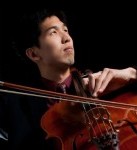Brian Yoon
Winner of the 2012 E. Gre Competition for New Music
Brian will open CIME with highlights from his winning performance at the E. Gre competition for new music.
Program notes for Casalmaggiore Recital
BRIAN YOON, cello
2012 E-Gré Competition Winner
Prayer and Dance of Praise (1997) – Elizabeth Raum (b. 1945)
Elizabeth Raum is both principal oboist with the Regina Symphony Orchestra and a prolific composer who enjoys a reputation of being one of Canada’s most “accessible” composers, writing for varied mediums and in remarkably diverse styles. Prayer and Dance of Praise was written for the 1997 Eckhardt-Gramatté Music Competition and received a nomination for Classical Composition of the Year at the 2010 Western Canadian Music Awards. It starts with a serious solo statement by the cello, becoming more passionate before returning to the solemnity of the opening. A dreamlike transition throws performers into a spirited dance that eventually ends in an exultant coda.
Bringing the Tiger Down From the Mountain II (1991) – Alexina Louie (b. 1949)
Alexina Louie is a Canadian composer of Chinese descent who has composed for various instrumental and vocal combinations in virtually every major genre. The title of this composition is derived from a Tai-Chi position. An extremely passionate solo section based on glissandi of minor thirds contrasts with the meditative quality of the passage where cello and piano alternate slow lines. The glissando section, marked “senza misura” frees the performers from the barline and demands that imagination and sensitivity be used to shape the passage. The duality of the yin-yang principle is embodied in the various contrasting characteristics of the piece.
Sonata for Cello and Piano, Op. 143 (1948) – Francis Poulenc (1899‐1963)
Although woodwind pieces dominate Poulenc’s chamber music oeuvre, the Sonata for Cello and Piano is a substantial work that finds the composer at the height of his powers. It was dedicated to the French cellist Pierre Fournier, who assisted the composer with some technical aspects of the cello. Cast in four movements, each of which is in a three-part form with a contrasting middle section, the sonata makes much use of Neo-Baroque and Neo-Classical styles. The first movement begins with a rude outburst from the piano, but lyricism quickly takes over, and the middle section is given over to playful treatments of the melodies. In the sublime Cavatine, the hymnlike piano opening creates an enchanted setting, which gradually builds to a passionate climax. The third movement is a Ballabile-a type of dance music often found in 19th century opera. It is marked ‘very lively and gay’ and one feels the vivacity of chatter amongst friends. The Finale begins with a stern cello recitative over striking piano chords; in a sudden burst of energy, the main Presto section scampers quickly through several episodes of short-breathed cello phrases and rippling piano passagework.
String Theory (2012) – John Burge (b. 1961)
String Theory was composed as the test piece for the 2012 E‐Gré Music Competition. The title is a bit of a play on words in the way that it makes reference to the branch of particle physics given the same label, while on the music side it represents a systematic or theoretical approach to writing for string instruments. Indeed, the work is a compendium of string effects such as glissandos, tremolos, harmonics, multiple-stopped chords, pizzicato and different bowing techniques. While the composition is structured in a contrasting slow-fast-slow design, a high level of cohesion is obtained as the music repeatedly comes back to the opening four-note motive heard initially in the piano. John Burge currently teaches Queen’s University in Kingston, Ontario. A passionate advocate for Canadian music, he was a member of the Executive of the Canadian League of Composers from 1993‐2007, serving as President from 1998‐2006. He is currently a member of the SOCAN Foundation board of directors.
Stigmata (2004) – Vincent Ho (b. 1975)
From Merriam-Webster Dictionary: “Stigmata―bodily marks or pains resembling the wounds of the crucified Christ and sometimes accompanying religious ecstasy.” Vincent Ho’s Stigmata for solo violoncello was written for cellist Jakub Omsky. The evocative title refers to the intense emotional content of the work, which was written after tragic events in the lives of both the composer and the dedicatee. In meetings with the composer over the internet, I learnt that his goal was to write something that would expose the performer’s soul, something that would allow the performer to convey his/her personal thoughts and emotions. In the end, he produced a dramatic work that drifts through moments of loneliness and desolation. Stigmata employs various pitch-bend techniques are organically built into the thematic material to convey expressive gestures (analogous to sighs, wails, etc). The piece concludes with a prayer-like section made up of artificial harmonic tremolos. Vincent Ho is currently the Composer-In-Residence to the Winnipeg Symphony Orchestra.
Variations on a Theme of Rossini (1942) – Bohuslav Martinů (1890‐1959)
Czech composer Bohuslav Martinů composed five works for cello and piano: three sonatas and two sets of variations, as well as several works for cello and orchestra. Dedicated to Gregor Piatigorsky, Variations on a Theme of Rossini was written in 1942 in the United States, and is based on an aria from Rossini’s opera “Moses in Egypt”. (Paganini had also used the theme in his famous set of variations to be played on one string.) The theme is rather comical, and the variations are similarly off-balance. Martinů effortlessly combines the virtuoso elements of cello technique with musical depth, rhythmic vitality and good humor.
